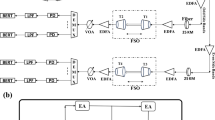Abstract
A light-emitting diode (LED) acts as a transmitter in a visible-light communication (VLC) system. However, the nonlinear characteristics of LED limit the performance of the VLC system by degrading the quality of a transmitted signal. In recent years, several forms of predistorters have been proposed to mitigate the effects of LED nonlinearity; however, none of them have been able to approach the performance of a linear VLC system. In this paper, we propose an adaptive learning architecture (ALA)-based predistortion technique to estimate and compensate for LED nonlinearities in a VLC system. A DC-biased optical orthogonal frequency division multiplexing signal is considered. The performance with and without predistorter is analyzed assuming optical channel. It is shown that degradation due to LED nonlinearity can be compensated by using ALA-based predistortion, and the overall predistorter–LED system is able to approach near-linear performance. Further, the proposed predistorter architecture is also able to track the variations in LED nonlinearity and compensate them. Simulation results based on error vector magnitude, symbol error rate, amplitude distortion (AM/AM) curves and constellation plots validate the performance of our proposed technique.











Similar content being viewed by others
References
Komine, T., Nakagawa, M.: Integrated system of white LED visible-light communication and power-line communication. IEEE Trans. Consum. Electron. 49(1), 71–79 (2003). https://doi.org/10.1109/TCE.2003.1205458
Komine, T., Nakagawa, M.: Fundamental analysis for visible-light communication system using LED lights. IEEE Trans. Consum. Electron. 50(1), 100–107 (2004). https://doi.org/10.1109/TCE.2004.1277847
Elgala, H., Mesleh, R., Haas, H.: Indoor optical wireless communication: potential and state-of-the-art. IEEE Commun. Mag. 49(9), 56–62 (2011). https://doi.org/10.1109/MCOM.2011.6011734
Karunatilaka, D., Zafar, F., Kalavally, V., Parthiban, R.: Led based indoor visible light communications: state of the art. IEEE Commun. Surv. Tutor. 17(3), 1649–1678 (2015)
Pathak, P.H., Feng, X., Hu, P., Mohapatra, P.: Visible light communication, networking, and sensing: a survey, potential and challenges. IEEE Commun. Surv. Tutor. 17(4), 2047–2077 (2015)
Elgala, H., Mesleh, R., Haas, H., Pricope, B.: OFDM visible light wireless communication based on white LEDs. In: 2007 IEEE 65th Vehicular Technology Conference—VTC2007-Spring, pp. 2185–2189 (2007). https://doi.org/10.1109/VETECS.2007.451
Armstrong, J., Lowery, A.J.: Power efficient optical OFDM. Electron. Lett. 42(6), 370–372 (2006). https://doi.org/10.1049/el:20063636
Armstrong, J.: OFDM for optical communications. J. Lightwave Technol. 27(3), 189–204 (2009). https://doi.org/10.1109/JLT.2008.2010061
Hranilovic, S.: On the design of bandwidth efficient signalling for indoor wireless optical channels. Int. J. Commun. Syst. 18(3), 205–228 (2005). https://doi.org/10.1002/dac.700
Gonzlez, O., Prez-Jimnez, R., Rodrguez, S., Rabadn, J., Ayala, A.: Adaptive OFDM system for communications over the indoor wireless optical channel. IEE Proc. Optoelectron. 153, 139–144(5) (2006). http://digital-library.theiet.org/content/journals/10.1049/ip-opt_20050081
Yu, Z., Baxley, R.J., Zhou, G.T.: EVM and achievable data rate analysis of clipped OFDM signals in visible light communication. EURASIP J. Wirel. Commun. Netw. 2012(1), 321 (2012). https://doi.org/10.1186/1687-1499-2012-321
Elgala, H., Mesleh, R., Haas, H.: A study of LED nonlinearity effects on optical wireless transmission using OFDM. In: 2009 IFIP International Conference on Wireless and Optical Communications Networks, pp. 1–5 (2009). https://doi.org/10.1109/WOCN.2009.5010576
Neokosmidis, I., Kamalakis, T., Walewski, J.W., Inan, B., Sphicopoulos, T.: Impact of nonlinear LED transfer function on discrete multitone modulation: analytical approach. J. Lightwave Technol. 27(22), 4970–4978 (2009). https://doi.org/10.1109/JLT.2009.2028903
Elgala, H., Mesleh, R., Haas, H.: Impact of LED nonlinearities on optical wireless OFDM systems. In: 21st Annual IEEE International Symposium on Personal, Indoor and Mobile Radio Communications, pp. 634–638 (2010). https://doi.org/10.1109/PIMRC.2010.5671734
Dimitrov, S., Sinanovic, S., Haas, H.: Clipping noise in OFDM-based optical wireless communication systems. IEEE Trans. Commun. 60(4), 1072–1081 (2012). https://doi.org/10.1109/TCOMM.2012.022712.100493
Dimitrov, S., Sinanovic, S., Haas, H.: Signal shaping and modulation for optical wireless communication. J. Lightwave Technol. 30(9), 1319–1328 (2012). https://doi.org/10.1109/JLT.2012.2188376
Tsonev, D., Sinanovic, S., Haas, H.: Complete modeling of nonlinear distortion in OFDM-based optical wireless communication. J. Lightwave Technol. 31(18), 3064–3076 (2013). https://doi.org/10.1109/JLT.2013.2278675
Elgala, H., Mesleh, R., Haas, H.: Non-linearity effects and predistortion in optical OFDM wireless transmission using LEDs. Int. J. Ultra Wideband Commun. Syst. 1(2), 143–150 (2009). https://doi.org/10.1504/IJUWBCS.2009.029003. http://www.inderscienceonline.com/doi/abs/10.1504/IJUWBCS.2009.029003
Elgala, H., Mesleh, R., Haas, H.: Predistortion in optical wireless transmission using OFDM. In: 2009 9th International Conference on Hybrid Intelligent Systems, vol. 2, pp. 184–189 (2009). https://doi.org/10.1109/HIS.2009.321
Mesleh, R., Elgala, H., Haas, H.: Led nonlinearity mitigation techniques in optical wireless OFDM communication systems. IEEE/OSA J. Opt. Commun. Netw. 4(11), 865–875 (2012). https://doi.org/10.1364/JOCN.4.000865
Ying, K., Yu, Z., Baxley, R.J., Qian, H., Chang, G.K., Zhou, G.T.: Nonlinear distortion mitigation in visible light communications. IEEE Wirel. Commun. 22(2), 36–45 (2015). https://doi.org/10.1109/MWC.2015.7096283
Kim, J.K., Hyun, K., Park, S.K.: Adaptive predistorter using NLMS algorithm for nonlinear compensation in visible-light communication system. Electron. Lett. 50(20), 1457–1459 (2014). https://doi.org/10.1049/el.2014.1835
Mitra, R., Bhatia, V.: Chebyshev polynomial-based adaptive predistorter for nonlinear LED compensation in VLC. IEEE Photon. Technol. Lett. 28(10), 1053–1056 (2016). https://doi.org/10.1109/LPT.2016.2528168
Mitra, R., Bhatia, V.: Precoded Chebyshev-NLMS-based pre-distorter for nonlinear LED compensation in NOMA-VLC. IEEE Trans. Commun. 65(11), 4845–4856 (2017). https://doi.org/10.1109/TCOMM.2017.2736548
Qian, H., Yao, S.J., Cai, S.Z., Zhou, T.: Adaptive postdistortion for nonlinear leds in visible light communications. IEEE Photonics J. 6(4), 1–8 (2014). https://doi.org/10.1109/JPHOT.2014.2331242
Ding, L., Zhou, G.T., Morgan, D.R., Ma, Z., Kenney, J.S., Kim, J., Giardina, C.R.: A robust digital baseband predistorter constructed using memory polynomials. IEEE Trans. Commun. 52(1), 159–165 (2004). https://doi.org/10.1109/TCOMM.2003.822188
Lee, T.P.: The nonlinearity of double-heterostructure LED’s for optical communications. Proc. IEEE 65(9), 1408–1410 (1977). https://doi.org/10.1109/PROC.1977.10728
Aggarwal, P., Ahmad, R., Bohara, V.A., Srivastava, A.: Adaptive predistortion technique for nonlinear LED with dimming control in VLC system. In: 2017 IEEE International Conference on Advanced Networks and Telecommunications Systems (ANTS), pp. 1–6 (2017). https://doi.org/10.1109/ANTS.2017.8384165
Arnon, S.: Visible Light Communication. Cambridge University Press, Cambridge (2015)
Barros, D.J.F., Wilson, S.K., Kahn, J.M.: Comparison of orthogonal frequency-division multiplexing and pulse-amplitude modulation in indoor optical wireless links. IEEE Trans. Commun. 60(1), 153–163 (2012). https://doi.org/10.1109/TCOMM.2011.112311.100538
Armstrong, J., Schmidt, B.J.C.: Comparison of asymmetrically clipped optical OFDM and DC-biased optical OFDM in AWGN. IEEE Commun. Lett. 12(5), 343–345 (2008). https://doi.org/10.1109/LCOMM.2008.080193
Barry, J.R., Kahn, J.M., Krause, W.J., Lee, E.A., Messerschmitt, D.G.: Simulation of multipath impulse response for indoor wireless optical channels. IEEE J. Sel. Areas Commun. 11(3), 367–379 (1993)
Komine, T., Nakagawa, M.: Performance evaluation of visible-light wireless communication system using white led lightings. In: Proceedings of 9th International Symposium on Computers and Communications, 2004, ISCC 2004, vol. 1, pp. 258–263. IEEE (2004)
Inan, B., Lee, S.C.J., Randel, S., Neokosmidis, I., Koonen, A.M.J., Walewski, J.W.: Impact of LED nonlinearity on discrete multitone modulation. IEEE/OSA J. Opt. Commun. Netw. 1(5), 439–451 (2009). https://doi.org/10.1364/JOCN.1.000439
Shafik, R.A., Rahman, M.S., Islam, A.R.: On the extended relationships among EVM, BER and SNR as performance metrics. In: 2006 International Conference on Electrical and Computer Engineering, pp. 408–411 (2006). https://doi.org/10.1109/ICECE.2006.355657
Wu, L., Zhang, Z., Dang, J., Liu, H.: Adaptive modulation schemes for visible light communications. J. Lightwave Technol. 33(1), 117–125 (2015)
Afgani, M.Z., Haas, H., Elgala, H., Knipp, D.: Visible light communication using OFDM. In: 2nd International Conference on Testbeds and Research Infrastructures for the Development of Networks and Communities, 2006. TRIDENTCOM 2006, pp. 6–134 (2006). https://doi.org/10.1109/TRIDNT.2006.1649137
Schulze, H.: Frequency-domain simulation of the indoor wireless optical communication channel. IEEE Trans. Commun. 64(6), 2551–2562 (2016)
Author information
Authors and Affiliations
Corresponding author
Additional information
Publisher's Note
Springer Nature remains neutral with regard to jurisdictional claims in published maps and institutional affiliations.
Rights and permissions
About this article
Cite this article
Aggarwal, P., Kabra, T., Ahmad, R. et al. Adaptive learning architecture-based predistorter for nonlinear VLC system. Photon Netw Commun 38, 258–269 (2019). https://doi.org/10.1007/s11107-019-00848-w
Received:
Accepted:
Published:
Issue Date:
DOI: https://doi.org/10.1007/s11107-019-00848-w




